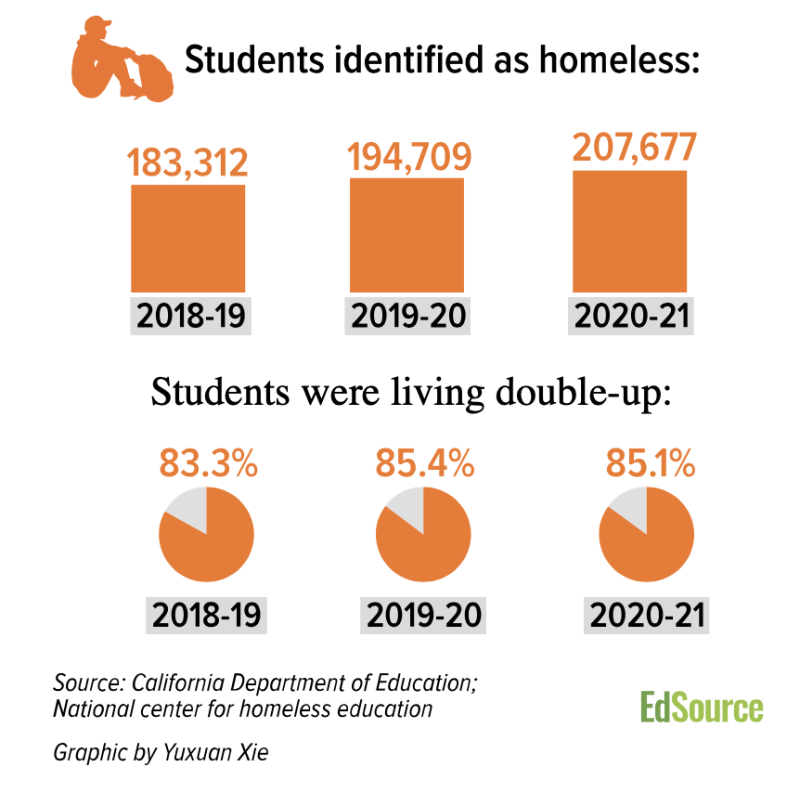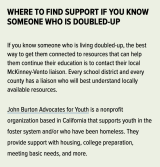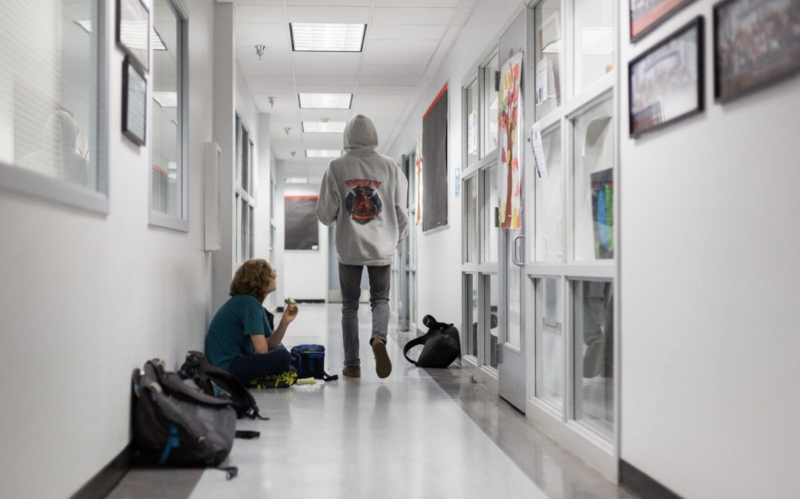Using the same data sources, 194,709 unhoused students were identified during the 2019–20 school year, and 85.4% were doubled-up. The year before that, 83.3% of the 207,677 students identified were doubled-up.
But some experts say these numbers might not be accurate or fully reflect reality. For example, despite the Census Day headcounts, the California Department of Education has estimated that the more accurate number of unhoused students is closer to 269,000 (PDF), and researchers at the UCLA Center for the Transformation of Schools have agreed.
“I don’t think anybody would say that we’re identifying all students who qualify, whether they’re doubled-up or in any other living situation,” said Jan Moore, director of technical assistance at the National Center for Homeless Education. “I don’t think anybody would say that we’re catching them all.”

Why does it matter that California officials know that the vast majority of the state’s unhoused students are doubled-up?
Identifying California’s unhoused students begins with understanding where they live and why they live there. A great challenge for schools is accurately counting all students who are unhoused, and learning that the majority are doubled-up can help guide the conversations they have with students. Plus, this information can help officials and liaisons seek resources specific to doubled-up students.
What is the McKinney-Vento Homeless Assistance Act, and why does it matter for doubled-up students?
The McKinney-Vento Homeless Assistance Act is a federal law that requires every public school to count the number of students who are living on the street, in shelters, in motels, in cars, doubled-up with other families or moving among friends’ and relatives’ homes. It mandates that every school district, county office of education and charter school hire a local liaison who must ensure that unhoused youth are identified and coordinate education services to increase their chances of succeeding academically.
This law defines unhoused students, in part, as “children and youths who are sharing the housing of other persons due to loss of housing, economic hardship, or a similar reason; are living in motels, hotels, trailer parks, or camping grounds due to the lack of alternative adequate accommodations; are living in emergency or transitional shelters; or are abandoned in hospitals.”
As a result, doubled-up students can receive McKinney-Vento resources and support to help continue their education as they face housing insecurity.
What resources are students eligible for if they are identified as unhoused under McKinney-Vento?
These students can remain enrolled in their “school of origin” and get state-funded transportation, if it’s decided that’s in their best interest, for the entire time they remain unhoused and through the end of the academic year during which they secure permanent housing. The “school of origin” includes schools that:
- The student attended when permanently housed.
- The student was last enrolled in when they became unhoused.
- The student has had some sort of connection to within the last 15 months.
If a student is not already enrolled in school, they must be enrolled immediately even if they do not have the typically required documents or if they missed an application deadline.
Additional resources can include replacement identification cards or birth certificates, free access to after-school programs and referrals to free immunizations. The goal is to ensure that unhoused students do not face challenges in completing coursework that would make them eligible to apply for college, in remaining enrolled in school, and in accessing extracurricular activities, among other things.
What are some of the challenges in identifying doubled-up students?
Homelessness is defined differently across various laws. A primary challenge for school staff is understanding the differences between how the McKinney-Vento law and the Department of Housing and Urban Development define homelessness. McKinney-Vento makes it easier to include doubled-up students as unhoused.
Moore said that some of the most common questions she receives from school staff are about whether a student might be doubled-up or not.
“We try to listen to each individual scenario because it is a case-by-case determination, and there are always little nuances that you have to listen really carefully to determine whether the student is eligible or not,” said Moore, whose team regularly hosts webinars to help school staff better understand student homelessness.
Often, it comes down to whether a student’s loss of housing was the result of a sudden crisis or a planned event. But learning those details highlights another challenge: gaining the trust of students and their guardians.
That trust is critical for a student and their guardian to feel comfortable disclosing their housing situation. While a liaison or other school staff member might notice red flags that could indicate homelessness, this isn’t always possible, leaving the student to self-identify.
Plus, the school staff member who gained that trust might leave their position.
“One of the problems that we’re seeing across the country is there has been a tremendous amount of turnover among liaisons and among state coordinators,” Moore said. She recommends that liaisons share with colleagues strategies for identifying and supporting students to lessen the impact of staff turnover.
How can schools and staff support students they think might be doubled-up?
An initial step is understanding what doubled-up means and sharing that information with students and families, said Moore.
Even once students are identified, however, McKinney-Vento has been found to fall short of fully supporting unhoused students. A 2020 UCLA report found that just 9% of school districts in California “received federal funding from the McKinney-Vento Act to meet the mandates of the law.” This means that only 1 in 3 unhoused students are attending schools with dedicated funding to support their education (PDF), which could include transportation to get them to their school of origin, providing ongoing basic needs such as food and toiletries, and the funding needed to hire a school liaison full-time (liaisons typically do this work in addition to another staff role on their campus).
Some federal lawmakers have called for increases in dedicated funding (PDF), but those efforts are stalled in Congress.
Is a student always considered unhoused if living in shared housing?
No. If two families are living under the same roof due to mutual benefit, they likely will not be considered unhoused. This is sometimes the case with multigenerational homes. But if that mutual benefit occurs due to a loss of housing, economic hardship or similar crisis, then they would be identified as unhoused. Understanding those nuances poses a challenge for liaisons.


